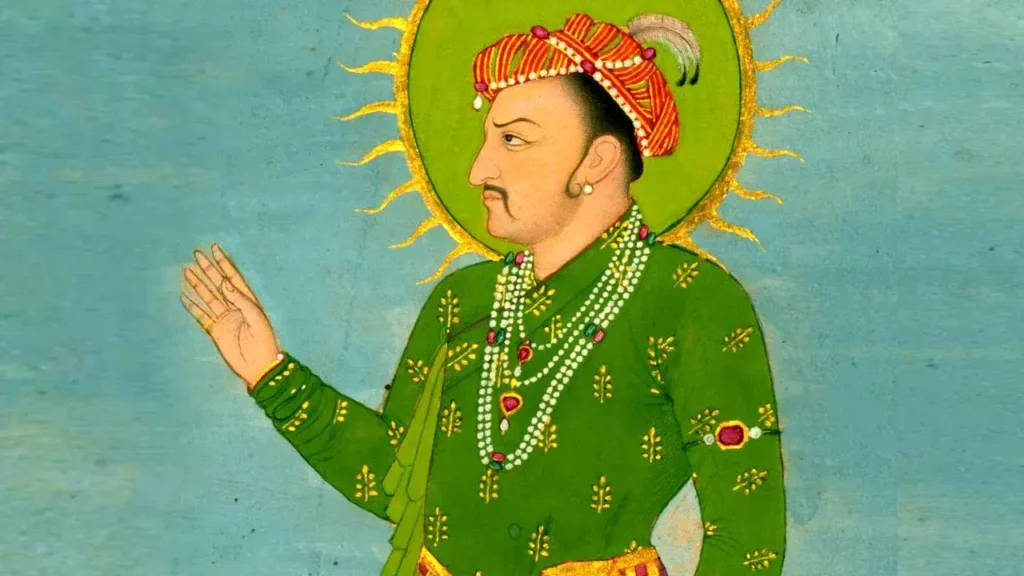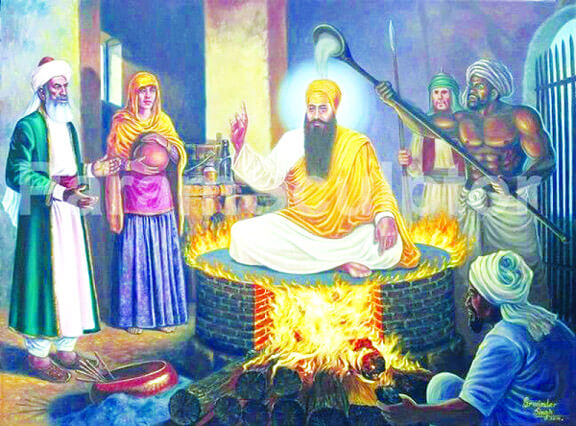
The martyrdom of Guru Arjan Dev Ji, the fifth Guru and the first martyr of the Sikh faith was a landmark in Sikh history. Guru Arjan Dev Ji was sentenced to death and brutally tortured on the orders of Mughal Emperor Jahangir, after he refused to stop preaching the message of God revealed by Guru Nanak Dev Ji. Guru Arjan Dev Ji attained martyrdom on June 16, 1606, on the banks of the Ravi River.
The martyrdom of Guru Arjan Dev Ji is regarded as a key moment in Sikh tradition which has influenced Sikh practices and beliefs.
The word Sikh is a corrupted form of the Sanskrit word disciple. Sikhism is the fifth largest and one of the youngest religions in the world founded by Guru Nanak Dev ji. The word Sikh in Punjabi means disciple of God – a person who worships one God and aspires to live a peaceful life of honesty, charity, equality, and faith.
Vision, compassion, and community

Guru Arjan Dev Ji was born in a Sodhi Khatri family on April 15, 1563, in Goindval, Punjab. He was the youngest of the three sons of Guru Ram Das (the fourth Sikh Guru) and Bibi Bhani, the daughter of Guru Amar Das (the third of the Ten Gurus of Sikhism). From a young age, he displayed a rare blend of wisdom, humility, and deep spiritual inclination. Arjan Dev became the 5th Guru on 16 September, 1581, following the footsteps of his father Guru Ram Das Ji. He became the first Guru to serve as both temporal and spiritual head of the Sikhs.
As one of the greatest of the Sikh Gurus, his immediate priority was to consolidate and expand the Sikh community. He took monumental steps to institutionalize Sikhism.
He prepared the Kartarpur Pothi on which the Adi Granth, or Guru Granth Sahib the sacred scripture and eternal Guru of the Sikhs is based. It contained the hymns of the Sikh Gurus as well as the —Hindu, Muslim, and Sufi saints—as per the pluralistic ethos of the Sikh faith. It was a revolutionary act of spiritual democratization, where divine wisdom was seen not as the monopoly of one religion or community, but as the shared voice of all lovers of God.
Guru Arjan Dev Ji also oversaw the completion of the Harmandir Sahib—the Golden Temple—in Amritsar. He designed the shrine to have four entrances, symbolizing openness and acceptance. It was a place of worship for all, regardless of caste, creed, or social status. Under his guidance, Amritsar flourished not just as a religious centre but as a vibrant, inclusive community rooted in service and spirituality.
The Mughal threat and rising tensions

However, this growing spiritual movement did not go unnoticed by the ruling Mughal establishment. By the early 17th century, the Mughal Empire under Emperor Jahangir was at a crossroads. The empire, though powerful, was deeply wary of any unifying force that lay outside its direct religious or political control.
In his memoir Tuzuk-i-Jahangiri, Jahangir candidly expresses his unease with the spread of Sikhism. He wrote:
“They call him [Guru Arjan] a spiritual leader. Many simple-minded Hindus and even some foolish Muslims have been enchanted by his ways. He has amassed a large following. I ordered his arrest and desired that he should be executed.”
Jahangir’s concerns were not merely religious; they were political. Guru Arjan Dev Ji’s support to Prince Khusrau, Jahangir’s rebellious son, during a period of dynastic conflict is cited as a contributing factor to the Guru’s arrest. Though the Guru offered only spiritual blessings, the political implications were serious in the eyes of the emperor.
Arrest, torture, and the final sacrifice

Guru Arjan Dev Ji was arrested and brought to Lahore, where he was subjected to inhuman torture over several days. He was made to sit on a red-hot iron plate while burning hot sand was poured over his body. He was scorched by the sun, denied food and water, and subjected to continuous physical torment.
Despite this unimaginable suffering, Guru Arjan Dev Ji maintained a divine serenity. He refused to convert to Islam or seek pardon. His spirit remained unbroken. His heart remained absorbed in the divine.
As his mortal body was consumed by fire and pain, his lips are believed to have whispered a line that has echoed through the centuries:
“Tera Kiya Meetha Laage, Naam Padarath Nanak Maange.”
(Whatever You do is sweet to me, O Lord. Nanak seeks only the gift of Your Name.)
On June 16, 1606, Guru Arjan Dev Ji achieved martyrdom on the banks of the Ravi River in Lahore. His body was consigned to the river by his followers. He became the first Sikh martyr, laying down his life not in war, but as a spiritual sacrifice in the face of tyranny.
A turning point in Sikh history

The martyrdom of Guru Arjan Dev Ji was not just a personal tragedy; it was a watershed in Sikh history. Until then, Sikhism had largely been a peaceful, contemplative faith, focused on spiritual upliftment and community service. But this brutal episode forced a fundamental shift.
His son and successor, Guru Hargobind Sahib Ji, recognized that in order to preserve the Sikh identity and protect the community, it was essential to combine spiritual strength with martial preparedness. He donned two swords—Miri and Piri, symbolizing temporal and spiritual authority. Under his guidance, the Sikhs began to train in arms and assert their rights, sowing the seeds of the later Khalsa movement.
Thus, the martyrdom of Guru Arjan Dev Ji not only affirmed the Sikh commitment to justice and truth but also birthed the spirit of self-defense and resistance that would characterize the Sikh community in the centuries to come.
Philosophical and spiritual legacy

Guru Arjan Dev Ji’s teachings continue to resonate deeply with Sikhs and spiritual seekers around the world. His compositions in the Guru Granth Sahib are filled with love, surrender, and longing for the Divine. He emphasized:
- Equality of all human beings
- Service to the poor and marginalized
- Living a truthful and disciplined life
- Acceptance of God’s Will (Hukam)
His life teaches that spiritual conviction must never bow before tyranny, and that the path of truth may demand great sacrifice, but ultimately leads to eternal liberation.
Commemoration and relevance today

The martyrdom of Guru Arjan Dev Ji is observed annually as Shaheedi Purab (Martyrdom Day), typically in the month of June, according to the Nanakshahi calendar. Across India and the Sikh diaspora, Chhabeel seva—offering cold sweetened water to the public—is performed to commemorate his sacrifice and propagate his values of service, humility, and love.
In today’s world—where religious intolerance, authoritarianism, and persecution of minorities continue to threaten peace—Guru Arjan Dev Ji’s martyrdom offers a powerful reminder. It reminds us that true strength lies not in domination, but in the courage to endure for what is just and right.
His example inspires millions to stand up for their beliefs, to serve humanity selflessly, and to meet adversity not with anger, but with the unflinching grace of the divine.
Conclusion: A martyr beyond religion

Guru Arjan Dev Ji’s martyrdom is not a story for Sikhs alone. It is a universal tale of spiritual resistance, of truth standing against tyranny, and of a leader who embraced death with dignity rather than dilute his principles.
He left behind not just a legacy of sacrifice but a path forward—a path lit by the eternal flame of justice, compassion, and faith. In honouring his memory, we do not merely look back—we carry forward the promise of his life: that the light of the soul can never be extinguished by force.

